India CCTV Camera Market Size
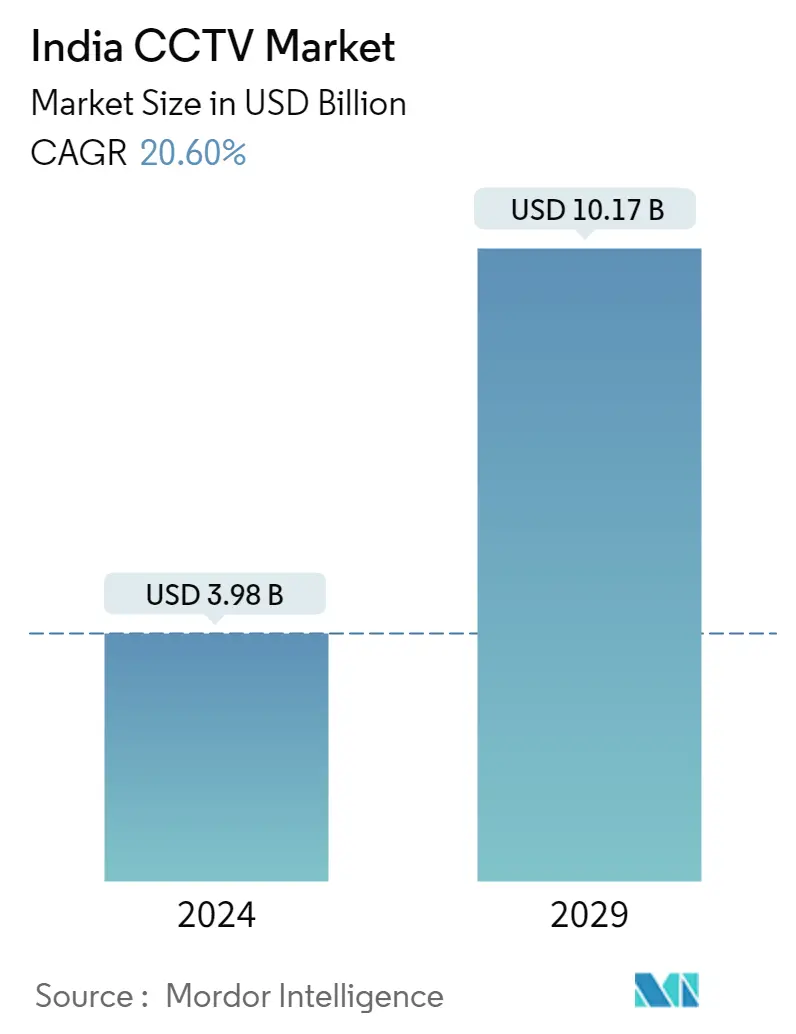
| Study Period | 2019 - 2029 |
| Base Year For Estimation | 2023 |
| Market Size (2024) | USD 3.98 Billion |
| Market Size (2029) | USD 10.17 Billion |
| CAGR (2024 - 2029) | 20.60 % |
| Market Concentration | Low |
Major Players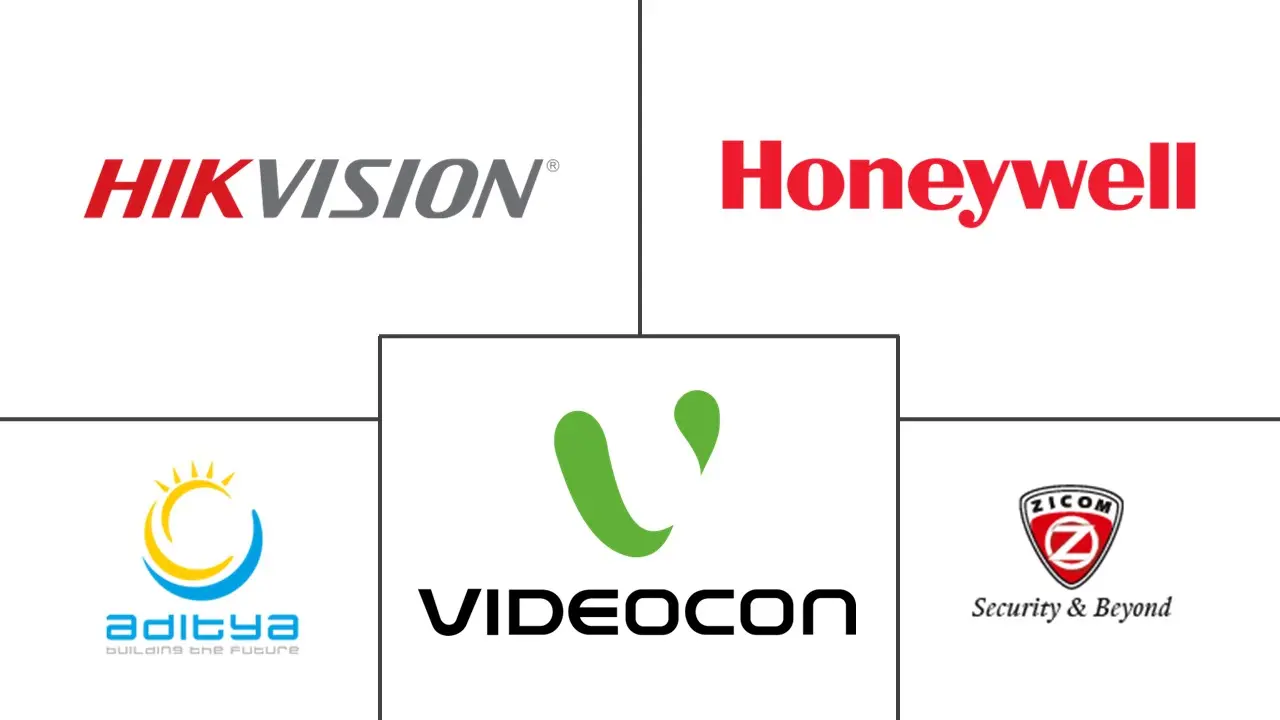
*Disclaimer: Major Players sorted in no particular order |
India CCTV Camera Market Analysis
The India CCTV Market size is estimated at USD 3.98 billion in 2024, and is expected to reach USD 10.17 billion by 2029, growing at a CAGR of 20.60% during the forecast period (2024-2029).
The attention to the importance of having CCTV cameras is growing as crime rates continue to remain high throughout the country. According to the city police commissioner of Delhi, in February 2022, the state reported 3,06,389 crime cases, up from 2,66,070 cases the previous year. Further, heinous crime cases in the national capital registered an almost 13% rise in the first six months of 2022 compared to last year. It reported 3,140 heinous crime cases until July 2022 compared to 2,790.
- The CCTV market has higher penetration in Tier 1 and 2 cities, which account for more than 80%. By region, the North dominates the CCTV market in India, followed by the South and West, contributing more than 55% of the market share (source: Hikvision). The major players in the Indian market are Godrej, Panasonic, Hikvision, Dahua, and others.
- The Indian Railways and the major transportation hubs in India are also deploying IP-based security techniques on a massive scale in waiting halls, reservation counters, parking areas, main entrances/exits, platforms, foot overbridges, booking offices, etc. According to the Indian Railways, the Ministry of Railways installed internet protocol (IP) based video surveillance systems (VSS) at railway stations to improve safety. Further, the railways are planning to install this video surveillance system (VSS) at 756 stations as part of the Nirbhaya Fund. The project's first phase, which includes significant stations in categories A1, A, B, and C, is expected to be finished by January 2023.
- Further, facial recognition, in particular, warrants a more in-depth discussion because of its increased use in public security projects. Around 16 different facial recognition systems are being deployed in other parts of the country by significant and various state governments, while 17 more are being deployed (source: Asmag). The railways have several surveillance cameras in use now, of which a few at the entrance and exit are used for facial recognition.
- For instance, in May 2022, Tenda, a networking device and equipment manufacturer, introduced the CP3, an AI-driven smart AI security camera with a 1080p image sensor for capturing Full HD footage. It has a pan/tilt design that allows for flexible rotation in all directions, covering 360° horizontally and 155° vertically (90° up, 65° down) with no blind spots.
- Furthermore, according to the construction world, the Indian Railways deployed nearly 500 facial recognition cameras to track millions of daily commuters. This is in line with the Indian government's improved surveillance efforts. The system was developed by NtechLab, a Russian start-up, and has been operational at approximately 30 railway stations in Gujarat and Maharashtra, including Mumbai, which will likely further drive the market growth.
- With the outbreak of COVID-19, the need for continuous monitoring in hospitals in India increased. The Maharashtra government made CCTV mandatory in all COVID-19 wards after receiving numerous complaints about hospital overcharging. Further, the Delhi government directed its Public Works Department (PWD) to install CCTV cameras in COVID-19 wards of all COVID-19-designated hospitals in New Delhi. Furthermore, artificial intelligence software could be loaded into CCTVs, which would perform the calculations and issue alarms if the appropriate social distance is not maintained.
India CCTV Camera Market Trends
This section covers the major market trends shaping the India CCTV Market according to our research experts:
IP Cameras are Expected to Hold Significant Share
- The rapid transition from analog to IP cameras has revolutionized the adoption of video surveillance solutions, including sharper, high-definition digital images and advancements in video analytics and neuro networks. As IP cameras transmit genuinely digital signals, they offer greater video detail, making them more suitable for facial recognition or detecting license plate numbers.
- For instance, in July 2022, Chinese tech behemoth Xiaomi launched its new home security camera in India, providing the Indian population with cutting-edge 360° solutions. The Xiaomi 360 Home Security Camera 1080 2i, available online and offline, is inexpensive and packed with features to create a 24-hour home security system.
- Further, the rise in production has also led to a decrease in prices and increasingly widespread adoption. With the integration of software solutions into video surveillance, it is now possible to detect unexpected and unattended objects or packages, line crossing, path tracking, etc.
- With the growing penetration of the internet and optimized connectivity, manufacturing plants have shifted from analog to IP cameras. For instance, BWI Automotive Technologies Pvt. Ltd has set up a plant in Haryana, India. The company is one of the significant technically advanced producers of high-quality automobile products and wanted to introduce CCTV surveillance to monitor production processes and ensure health and safety policies were followed. After analyzing analog, hybrid, and IP-based CCTV systems, the management decided to use IP based system. The company has selected IP owing to the ease of integration with CCTV and its existing network of cost-saving technologies such as PoE (Power over Ethernet) and UPS (Uninterruptible Power Supplies). The company has installed CP Plus'sPlus's IP CCTV systems to surveillance the plant.
- The manufacturing industry is witnessing robust growth across all the regions globally. The increasing number of newly constructed and renovated manufacturing arguments the demand for IP cameras to provide complete security in and around the manufacturing premises. According to MOSPI, in January 2022, India's manufacturing sector declined by more than 7%. This was due to the economic slowdown caused by the COVID-19 pandemic. However, in 2022, manufacturing accounted for approximately 12.5 % of the country's GVA.
- Furthermore, the Indian government has recently increased efforts to promote manufacturing in India. This has prompted many foreign manufacturers to consider making CCTV devices in India, with significant contributions from local component manufacturers. The government has also categorized the products into two forms, which are L1 and L2. Products made using more than 50% locally made components come under the L1. Those that operate between the range of 20-50% of local parts come under L2. For government projects, the products should either be L1 or L2.
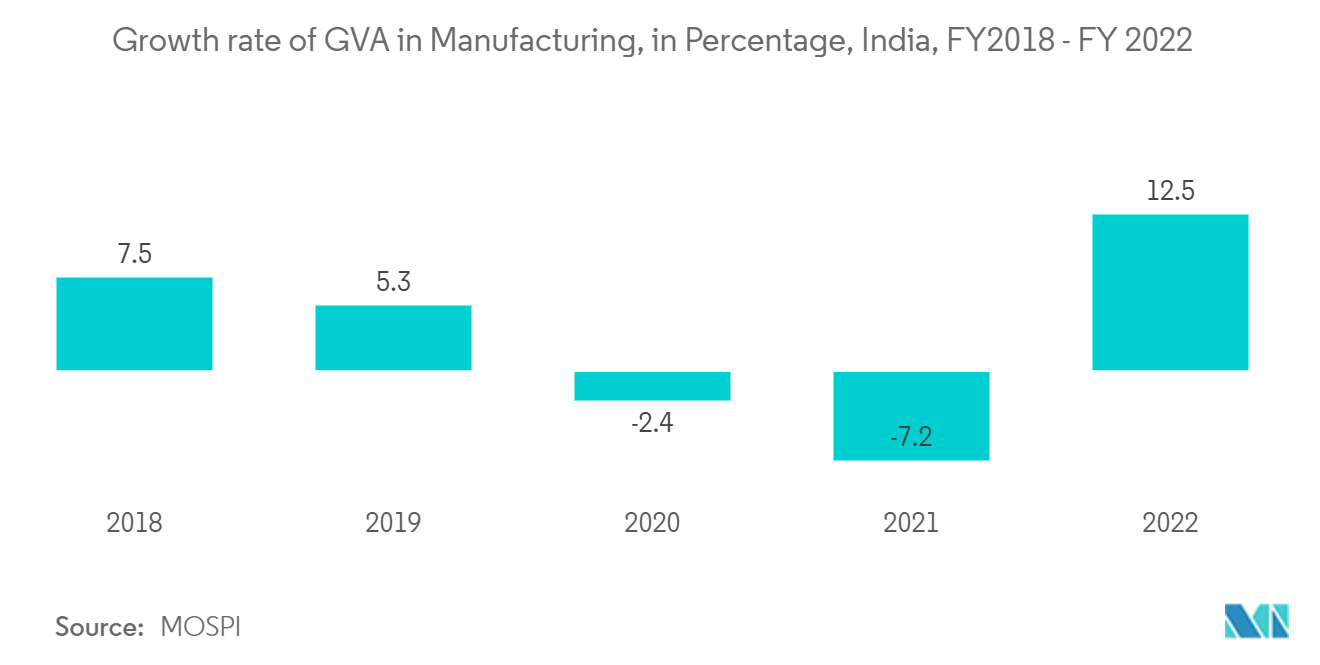
Government Segment is Expected to Hold Significant Market Share
- The government sector contributes significantly to India's CCTV camera market growth. With the advent of CCTV devices, policing has changed entirely. In any criminal investigation, a CCTV is the first instrument and handy tool to crack the case. Chennai has the maximum CCTV coverage per square kilometer (657) and per 1,000 population (25.5) among the 130 cities studied worldwide. At the second spot, Hyderabad city has maximum CCTV coverage per square kilometer (480) and per 1,000 population (30.0).
- Additionally, state governments in India are increasingly implementing video surveillance equipment to improve security and safety. For instance, the Telangana government primarily focuses on enhancing street surveillance to improve Hyderabad's safety. In August 2022, Greater Hyderabad Municipal Corporation (GHMC) approved a proposal to install 8,000 CCTV cameras across parks and slums in the city. According to the proposal, 975 parks and 311 unnotified slums would be under CCTV surveillance. GHMC officials plan to finalize the project at an estimated cost of INR 20 crore by the year's end.
- The government sector is also focused on installing technologically advanced cameras for surveillance. For instance, in January 2022, the Mumbai Police extended the deadline for all private and commercial buildings in the city to install CCTV cameras by two months. Shopkeepers or commercial establishment owners who refuse to comply with it despite having their stores in high-crime areas may face legal consequences.
- Further, with innovative city initiatives, in June 2022, to improve surveillance, the Gurugram Metropolitan Development Authority (GMDA) established eight cameras equipped with facial recognition technology at the entrance and exit gates of the MG Road Metro station. It plans to install eight more at the Sikanderpur Metro station later this year.
- Furthermore, the Supreme Court recently issued a notice to the Delhi government in a petition filed against the Delhi government's order to install CCTV cameras in school classrooms and make the footage available to parents of children in the schools in real time.
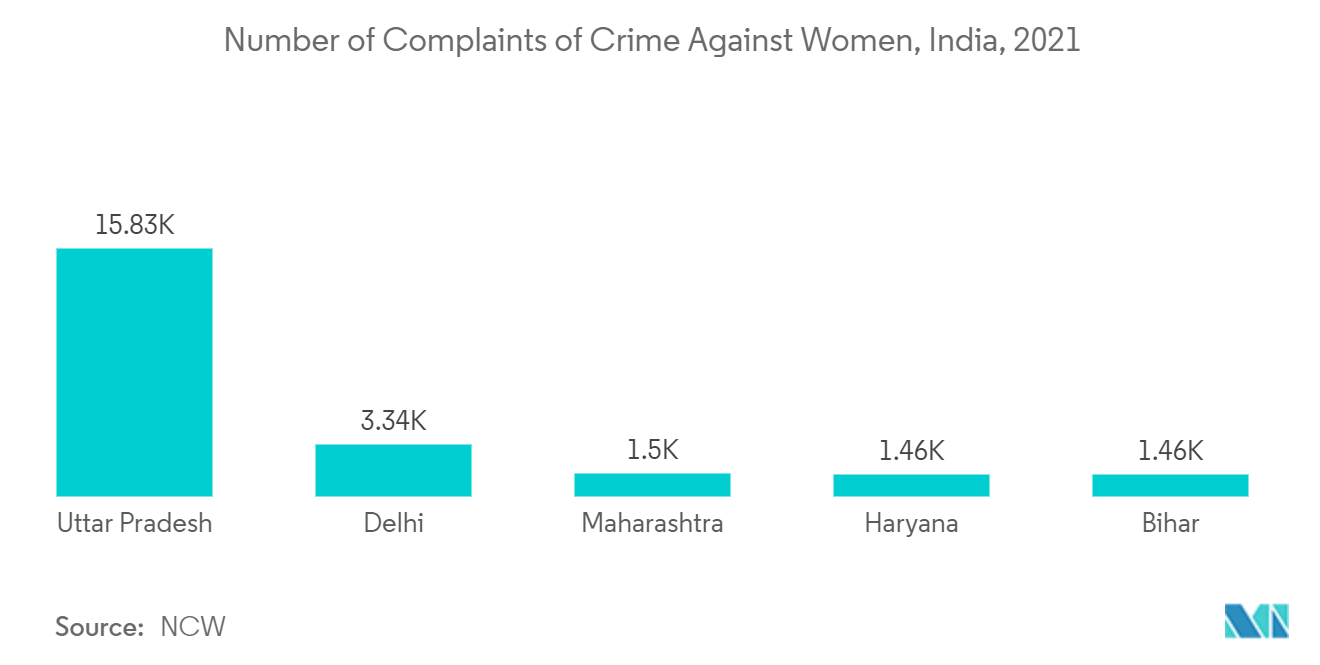
India CCTV Camera Industry Overview
The Indian CCTV market is fragmented due to significant players, such as Aditya Infotech Ltd (CP Plus GmbH & Co KG), Videocon Industries Limited, D-Link India Limited, Godrej Security Solution, Honeywell Commercial Security, Axis Video Systems India Pvt. Ltd, Everfocus Electronics (I) Pvt. Ltd, etc. Technological advancements are also bringing considerable competitive advantage to companies, and the market is witnessing multiple mergers and partnerships.
- June 2022: Dahua Technology officially launched the full-color smart dual illuminators camera series at its 2022 full-color online launch. The latest series integrates two illuminators, warm light, and infrared light, with three supplementary light modes to provide clear and vivid full-color images while avoiding continuous use of warm light, providing a flexible solution for various night and low-light monitoring scenarios.
India CCTV Camera Market Leaders
-
HIKVISION Digital Technology Co, Ltd. (Hikvision India)
-
Honeywell Commercial Security (Honeywell International Inc)
-
Aditya Infotech Ltd. (CP Plus GmbH & Co KG)
-
Videocon Industries Limited
-
Zicom Electronic Security Systems
*Disclaimer: Major Players sorted in no particular order
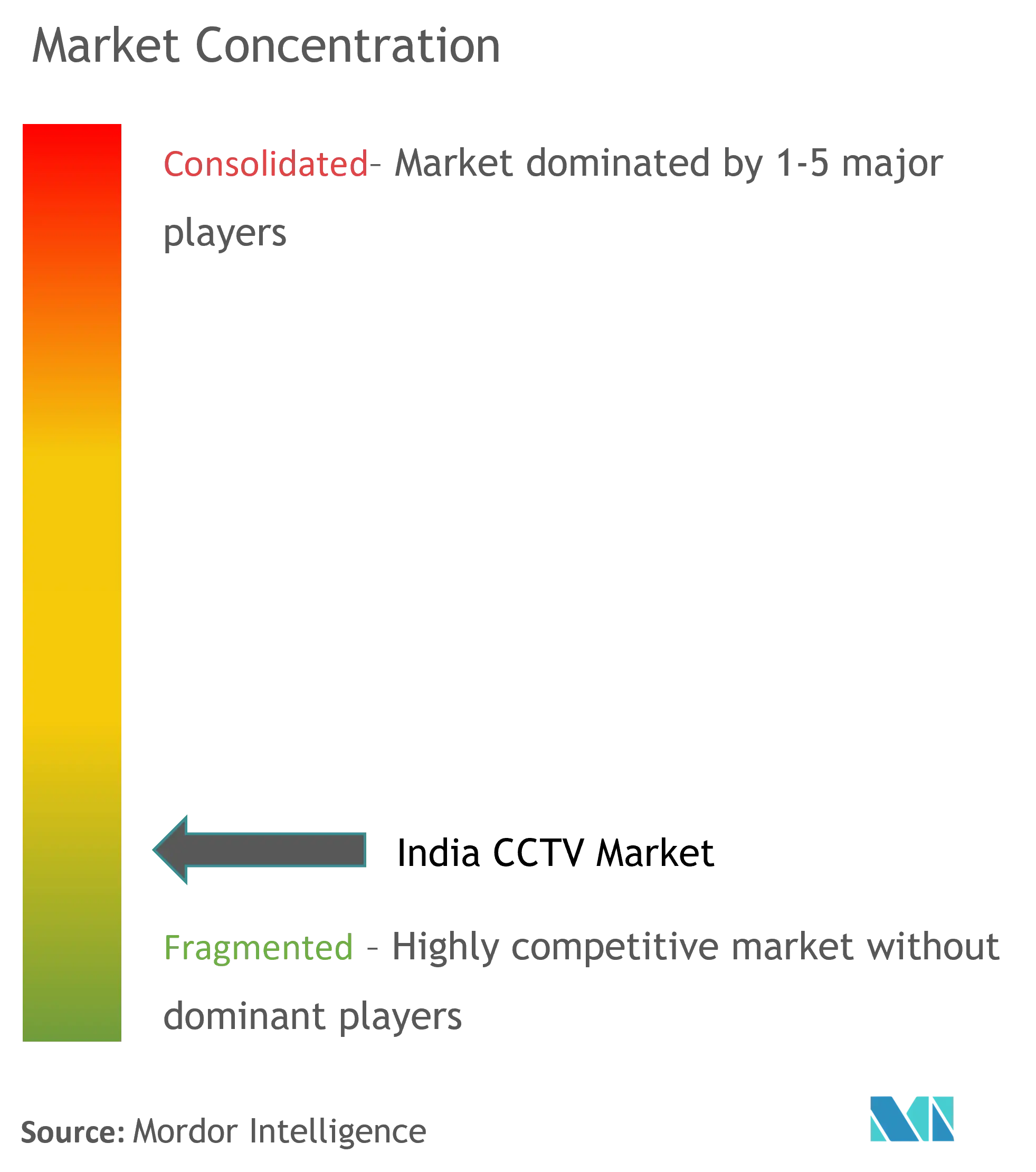
India CCTV Camera Market News
- August 2022: Hanwha Techwin, a global supplier of intelligent video surveillance solutions, launched a significantly updated version of its WisenetWAVE Video Management Software (VMS) in response to the changing needs of security professionals and system integrators. Version 5.0 expands the platform's focus on cybersecurity, system usability, convenience, and interactivity. It features advanced object search, metadata-driven active backup, webpage proxy via servers, two-factor authentication (2FA), resource grouping, audio mapping, etc.
- April 2022: The Telangana State Police Department formed the Telangana Public Safety Society. Through this society, which is registered under the Societies Act, the department seeks to raise funds for installing and maintaining CCTV cameras throughout the state.
India CCTV Camera Market Report - Table of Contents
1. INTRODUCTION
- 1.1 Study Assumptions and Market Definition
- 1.2 Scope of the Study
2. RESEARCH METHODOLOGY
3. EXECUTIVE SUMMARY
4. MARKET INSIGHTS
- 4.1 Market Overview
-
4.2 Industry Attractiveness - Porter's Five Forces Analysis
- 4.2.1 Bargaining Power of Suppliers
- 4.2.2 Bargaining Power of Consumers
- 4.2.3 Threat of New Entrants
- 4.2.4 Threat of Substitutes
- 4.2.5 Intensity of Competitive Rivalry
- 4.3 Industry Value Chain Analysis
- 4.4 Assessment of Impact of COVID-19 on the Market
5. MARKET DYNAMICS
-
5.1 Market Drivers
- 5.1.1 Increasing Concern about Privacy Across Various Enterprises, Public Sectors and Residential Associations
- 5.1.2 Traffic Surveillance, and Security in Educational Institutes, Railways and Hospital to Augment the Demand of CCTV Cameras
- 5.1.3 Growth of Smart Cities and Airport Security
- 5.1.4 Government Regulations Enforcing the Setup of Surveillance Infrastructure Across Various Cities
-
5.2 Market Restraints
- 5.2.1 Limited Customer Awareness Pertaining to Specific Usage of Surveillance Cameras
- 5.2.2 High Cost of Video Surveillance Camera
-
5.3 Market Opportunities
- 5.3.1 IP-based Surveillance System to Attract Huge Installation of Video Surveillance Cameras
- 5.3.2 Emergence of IoT, video analytics and HD CCTV to Provide Substantial Growth Opportunities
- 5.4 Domestic Production vs Imports
- 5.5 India Import and Export Data for Subcomponents
6. MARKET SEGMENTATION
-
6.1 By Type
- 6.1.1 Analog Cameras
- 6.1.2 IP Cameras (excluding PTZ)
- 6.1.3 PTZ Cameras
-
6.2 By End-user Verticals
- 6.2.1 Government
- 6.2.2 Industrial
- 6.2.3 BFSI
- 6.2.4 Transportation Vertical
- 6.2.5 Other End-user verticals (Hospitality and Healthcare, Enterprises, Retail, Educational Institutions)
7. ANALYSIS OF THE DEMAND PATTERN OF CCTV CAMERA IN MAJOR INDIAN CITIES
- 7.1 North
- 7.2 East
- 7.3 South
- 7.4 West
8. COMPETITIVE LANDSCAPE
-
8.1 Company Profiles
- 8.1.1 HIKVISION Digital Technology Co, Ltd. (Hikvision India)
- 8.1.2 Honeywell Commercial Security (Honeywell International Inc)
- 8.1.3 Aditya Infotech Ltd. (CP Plus GmbH & Co KG)
- 8.1.4 Videocon Industries Limited
- 8.1.5 Zicom Electronic Security Systems
- 8.1.6 Dahua Technology India Pvt. Ltd.
- 8.1.7 D-Link India Limited
- 8.1.8 Godrej Security Solution
- 8.1.9 Axis Video Systems India Pvt. Ltd
- 8.1.10 Bosch Security Systems India
- 8.1.11 Electronic Eye Systems
- 8.1.12 Vantage Security Ltd
- 8.1.13 Vintron informatics Ltd
- 8.1.14 Digitals India Security Products Pvt. Ltd
- 8.1.15 Total Surveillance Solutions Pvt. Ltd
- *List Not Exhaustive
9. INVESTMENT ANALYSIS
10. FUTURE OF THE MARKET
** Subject To AvailablityIndia CCTV Camera Industry Segmentation
Closed-circuit television (CCTV), also known as videotape surveillance, is used to send a signal to a specific site using a limited number of monitors. In India, the demand for CCTVs is surging due to privacy concerns and innovative city initiatives. The study includes market drivers and challenges, along with enterprise attractiveness. The market scope comprises different types of CCTVs (analog and IP (fixed and PTZ)) among end-user verticals such as government, industrial, BFSI, transportation, and other end-user verticals.
The impact of COVID-19 on the market studied and segments are also covered under the scope of the study. Further, the disruption of the factors impacting the market's growth in the near future has been covered in the study regarding drivers and restraints.
The market sizes and forecasts are provided in terms of value (USD million) for all the above segments.
| By Type | Analog Cameras |
| IP Cameras (excluding PTZ) | |
| PTZ Cameras | |
| By End-user Verticals | Government |
| Industrial | |
| BFSI | |
| Transportation Vertical | |
| Other End-user verticals (Hospitality and Healthcare, Enterprises, Retail, Educational Institutions) |
India CCTV Camera Market Research FAQs
How big is the India CCTV Market?
The India CCTV Market size is expected to reach USD 3.98 billion in 2024 and grow at a CAGR of 20.60% to reach USD 10.17 billion by 2029.
What is the current India CCTV Market size?
In 2024, the India CCTV Market size is expected to reach USD 3.98 billion.
Who are the key players in India CCTV Market?
HIKVISION Digital Technology Co, Ltd. (Hikvision India), Honeywell Commercial Security (Honeywell International Inc), Aditya Infotech Ltd. (CP Plus GmbH & Co KG), Videocon Industries Limited and Zicom Electronic Security Systems are the major companies operating in the India CCTV Market.
What years does this India CCTV Market cover, and what was the market size in 2023?
In 2023, the India CCTV Market size was estimated at USD 3.30 billion. The report covers the India CCTV Market historical market size for years: 2019, 2020, 2021, 2022 and 2023. The report also forecasts the India CCTV Market size for years: 2024, 2025, 2026, 2027, 2028 and 2029.
CCTV in India Industry Report
The importance of surveillance cameras in India is growing due to high crime rates, leading to increased market penetration, particularly in Tier 1 and 2 cities. Major players in the market include Godrej, Panasonic, Hikvision, Dahua, and others. The Indian Railways and other major transportation hubs are deploying IP-based security systems extensively, including facial recognition systems. The demand for security cameras is surging due to privacy concerns and innovative city initiatives. The market includes different types of video surveillance among end-user verticals such as government, industrial, BFSI, transportation, and others. The government sector contributes significantly to India's surveillance camera market growth, with state governments implementing surveillance equipment to improve security and safety. The Indian video security market is fragmented due to significant players and technological advancements. For a more detailed analysis, a free PDF download of the report is available.



